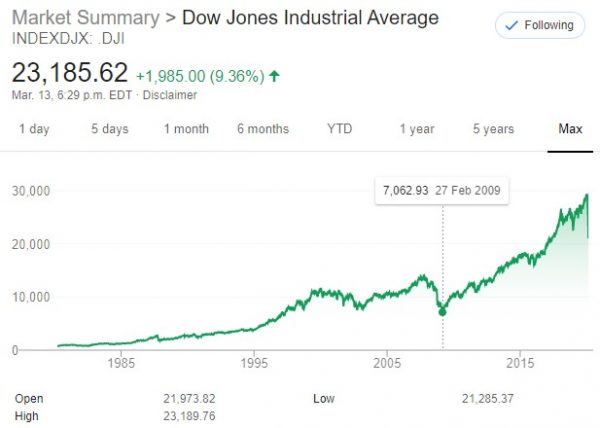By Mark Seed
Special to the Financial Independence Hub
Unless you’ve been living under a rock, the stock markets have been a terrible mess.
On our Canadian side, we triggered market circuit breakers to halt trading in recent days.
In the U.S., the stock market dropped thousands of points in rapid successive trading days and remains well into bear-market territory within just a matter of weeks. It’s as almost if the market jumped out of a plane with a faulty parachute and spiraled out of control to earth; only some mild turbulence kept it from a total free fall.
All havoc, no sanity
These market dives in very short order made me reflect on my own investing journey and how I might be able to survive this stock market crash. For today’s post, here are my ideas on how to get through a stock market crash – and benefit from it.
1.) Learn from history – reset your expectations
A sudden stock market crash is quite unnerving, but I don’t think it’s a sign of imminent full-on financial collapse. At least history tells us so. You’ll see from the chart above, recent weeks have been very messy to say the least. But over many years of investing in equities, the chart actually looks like this:
I’ve highlighted near the bottom of the 2008-2009 Great Recession for reference.
Although it’s very difficult to wrap your head around this fact and behave accordingly, stock market history consistently tells us the financial markets do eventually recover. And, after they recover, looking back through time, they continue to deliver rather predictable long-term returns. Here is what the U.S. stock market has returned by the decade and from what:
Source: https://awealthofcommonsense.com/2019/12/where-have-all-the-stock-market-returns-come-from-this-decade/
Even near-term, our Canadian and U.S. stock markets have been a very good place to be to build wealth:
| Index | Proxy Fund | 5-year return | 10-year return | Since inception |
| S&P/TSX (Canada) | XIC | 6.27% | 6.77% | 6.53% (2001) |
| S&P 500 (U.S.) | IVV | 11.65% | 13.50% | 6.15% (2000) |
Source: iShares site, up to December 2019.
I firmly believe this is why you need to stay invested throughout a stock market crash.
What goes down will (eventually) go back up in time.
2.) Learn from history – buy when stocks are on sale
The fact that equity markets have done well over the last decade, let alone generations (despite the occasional very scary bump) should be a reminder that stocks remain a great long-term investment to build wealth. But as we all know by now, scary bumps can and do happen. As in now.
This means selling stocks in a panic (also as in now) is probably not a wise move. Ideally, successful investing is about buying something at a low to modest price and watching that asset accumulate in value. That means staying investing like I mentioned above but that also means buying low, selling high (if you need to sell at all). When you sell after a market crash or a major correction you do just the opposite.
You and I both know by now we cannot control market swings. We can control our investing behaviour. We have no idea of when the market will swing nor by how much. We only know that it will.
The best time to buy stocks is when you were going to buy them anyway.
So, I believe, you should consider stock market crashes as a buying opportunity. I mean, a market correction or crash simply signifies stocks are on sale per se. Consider the following and your behaviours associated with these statements:
- Would you panic sell your house if it dropped 20% in value in a few days or weeks?
- Would you buy more gas for your car if it dropped 20% at the pumps?
- Would you buy more groceries and toilet paper if it was on sale during the impending viral apocalypse?
You know your answer and I know yours too.
So why is the stock market different?
Much has been written about buying in lump sums being somewhat more favourable than any dollar-cost averaging (i.e., buying-in slowly) during a market correction. To be honest, I don’t care what you pick. Just invest.
As Jonathan Clements, a former Wall Street Journal columnist once said:
“If you want to see the greatest threat to your financial future, go home and take a look in the mirror.”
This implies that successful long-term investing is directed tied to your emotional fortitude and behavioural discipline. While poor investing decisions can and may very well occur from time to time, it’s important to learn from them. It is therefore imperative that investors recognize their behavioural pitfalls before committing to any decisions which can affect their investment goals.
One of my favourite, easy-to-read books on the subject of building wealth is targeted to millennial investors but applies equally to investors of all ages is If You Can. This book is designed for modern attention spans. It’s only 15-minutes of reading and gives you information you need to be a successful investor in a few pages.
You can read an overview of this book and download a FREE copy of it (yes FREE) here.
3.) Learn from history – continue to improve
How high your returns could be (for a long-term stock market investor) over the next 30+ years is not really up for too much debate – based on market history. A 100% equity portfolio in the broad U.S. stock market is probably going to deliver close to 7% annualized (plus or minus a bit) and likely 3-4% in real returns (after inflation is factored in) in the coming decades.
I can say with more confidence that I will not find myself wealthier if I do not learn from my own investing history and continue to improve upon it over time.
I got a few reader emails over the last few weeks and I thought I would share them before I share my next steps in this current market correction for context – what I’m doing to improve. Emails adapted only slightly for posting.
Reader 1:
Mark,
I have read a lot about the stock markets. I have been investing since 1985. One question that seems to go unanswered is what should you do when your investments have increased substantially in value? This question comes up as we see the markets plunge, as they have done several times since 1985. I see my total portfolio substantially drop in value, and I know it will eventually return to that level or more.
I am wondering if there is any strategy to capture some of those gains? I have good quality investments, no get rich quick stock picks, and I invest regularly, every month. I know the credos – stay the course – don’t time the markets – the market has returned an average of 9% over 72 years – the value will return in 6 months – but they seem like messages meant to keep you in the game. Maybe that’s all it is, you are playing a game and these are the perennial rules. Something to remind yourself about as markets correct.
Reader 2:
Mark,
Of course no one likes this type of market but it can be made more manageable if you have a catastrophe plan. I have had such a plan for the last 6 years. Don’t want to use it but if you must…..
For what it’s worth, my plan has consisted of converting my RRSP into a RRIF early (age 68) rather than mandatory age 71. With over $1 M invested even after this market correction I felt it (the market) absolutely had to come down in size (or I’d get too much income in my later years).
I stressed tested it so if it lost 50% of my portfolio it would still deliver a good $25,000 a year, + Canada Pension Plan (CPP) + Old Age Security (OAS) = $42,000 per year base. My non-registered account (like you) churns out dividends. That account gives me about $20,000 in dividends and if these dry up I will rely on my cash in hand to supplement my yearly base. I can last a good 10 years that way until the market returns. Not really worried but would obviously prefer steady growth. So would everyone else!
What is clear from each of these readers if they’ve learned to adapt and improve. They’ve learned from market history, they’ve learned to embrace stocks, and they’ve learned to keep cash or fixed-income for the inevitable market crash or correction.
From the Elements of Investing:
“As in so many human endeavours, the secrets to success are patience, persistence, and minimizing mistakes.”
So what I am doing in this market correction?
I’m going to buy more stocks and ETFs.
While I have a plan to increase my cash wedge in the coming years, something you can read about here – how much cash should you keep,I plan on buying more U.S. stocks or low-cost ETFs in the coming months. I might buy more of low-cost dividend ETF VYM that I currently hold. I might buy some iShares ITOT ETF for broad U.S. market exposure. I might buy some Microsoft (MSFT) or another blue-chip company to go with my existing portfolio of U.S. stocks such as JNJ, PG, AT&T, and Verizon. I might just buy some of all three.
By increasing my diversification and continuing to improve upon it over time, I will further mitigate investment risk while realizing my goals along the way. Likely the best way I can do this is via a broad-market index fund.
Paraphrased from investing guru Charles Ellis:
The buy-and-hold investor who prudently holds a diversified portfolio of low-cost index funds through thick and thin is the investor most likely to achieve their long-term investment goals.
Summary
At the end of the day, I have no idea what the future holds. Don’t let any financial expert tell you they know either.
During times of market euphoria or market crisis I’m going to continue doing what I’ve always been doing:
- I will continue to pay down debt to become debt-free.
- I will keep savings automatic for investment purposes – putting money aside every month.
- With money ready to invest, I will periodically buy stocks and equity ETFs a few times during the year.
- As part of my improvement measures, I will consider buying more broad-market U.S. indexed ETFs to remove individual stock selection risk and increase diversification.
Continual learning from market history, learning to live with stocks now and buying more of them when they are on sale, will reward my future financial self. I suspect the same will apply to you in how to get through this stock market crash – and benefit from it.
 Mark Seed is a passionate DIY investor who lives in Ottawa. He invests in Canadian and U.S. dividend paying stocks and low-cost Exchange Traded Funds on his quest to own a $1 million portfolio for an early retirement. You can follow Mark’s insights and perspectives on investing, and much more, by visiting My Own Advisor. This blog originally appeared on his site on March 17, 2020 and is republished on the Hub with his permission.
Mark Seed is a passionate DIY investor who lives in Ottawa. He invests in Canadian and U.S. dividend paying stocks and low-cost Exchange Traded Funds on his quest to own a $1 million portfolio for an early retirement. You can follow Mark’s insights and perspectives on investing, and much more, by visiting My Own Advisor. This blog originally appeared on his site on March 17, 2020 and is republished on the Hub with his permission.




